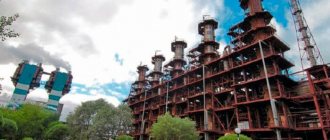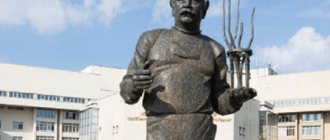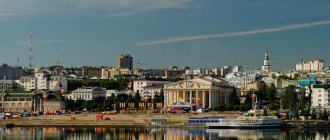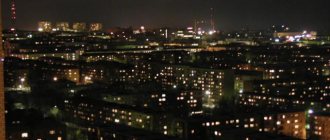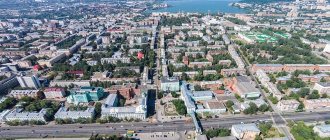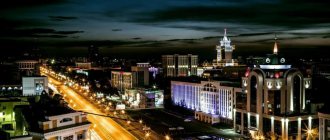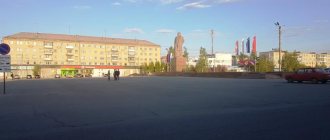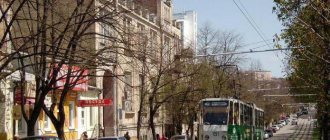Physiographic characteristics
Geographical position
Located in the European part of Russia, on the Ai River (Ufa River basin), 120 km west of the regional center of Chelyabinsk (160 km by rail) and 1,750 km east of Moscow (1,941 km by rail). The historical route of the Trans-Siberian Railway passes through the city, and the federal highway M-5 “Ural” runs near the city. The city covers an area of 118.2 km². The length from south to north is 15.4 km, from west to east 10.4 km.
Relief and geological structure
View of the historical center of the city from Mount Kosotur, 1900. In the background is the dam of the factory pond, the arms factory, the Holy Trinity Cathedral, then Mount Butylovka.
It is located in the mountainous forest part of the Chelyabinsk region, in the valley of the Ai River, formed by the mountain ranges of the Southern Urals. In the east there is the Uraltau ridge, in the west - the Urenga ridge and the Myshlyai mountains. From the north, the valley is closed by Taganay and the Nazminsky ridge. The city's topography is typically mountainous, with sharp changes in elevation.
In the center of the city, at the confluence of the Tesma River and the Ai, there is a city pond.
Climate
The climate is temperate continental. Mountains influence the climate, making it more humid and reducing the annual range of air temperatures based on monthly averages.
- average annual air temperature: +1.9 °C;
- relative air humidity: 69.2%;
- average wind speed: 3.5 m/s;
Timezone
Story
Chrysostom
Holy Trinity Cathedral. View from the southwest. Approximately 1900 Monument to P.P. Anosov, Third International Square The first Russian temporary settlement on the territory of modern Zlatoust arose at the end of the 17th century in connection with the search for gold. In 1664, Elder Lot from the Dalmatovsky Assumption Monastery admitted under torture that he had made a trip to the Southern Urals, during which he was informed that gold and silver was being smelted on Lake Irtyash, mined on the “Siberian Mountain”, located in the upper reaches of Ufa, Yaika and Gadai. In 1668-1674, a large military-geological expedition was equipped, consisting of more than 1 thousand people with guns and equipment, which in 1672 built the Novo-Uralsky fort in the area of the current Taganay National Park. This fort became the first Russian settlement on the territory of the modern Chelyabinsk region. However, geological research ended in complete failure, which is stated in the chronicle in the following terms: “ Nothing was found, and great futility and destruction was caused to the sovereign’s treasury.”
" After the failure, the fort was abandoned. In 1708, the story about the “Siberian Mountain” was accidentally discovered in the documents of the Siberian Provincial Chancellery and reported to the secretary of Peter I A.D. Makarov. V.N. Tatishchev was instructed to check the information about silver ore. In the 1720s, a new expedition working near the ruins of the fort did not find metal in the local rock. In 1741, a new expedition arrived at the destroyed fort, which discovered iron ore and chose a place to build the Zlatoust plant.
In 1754, A.P. Mosolov, on patrimonial lands purchased from the Bashkirs near Mount Kosotur, founded an ironworks, which was later named in honor of St. John Chrysostom Zlatoust
. The decree of the Berg College on the construction of the plant was issued on August 31, 1754. The plant got its name due to the intentions of the owners to build a church in the name of St. John Chrysostom in the factory village, which was built in 1865. Thus, the plant received its name long before construction began. According to local historians, the image of John Chrysostom was the family icon of the family of the founder of the plant, entrepreneur A.P. Mosolov.
In 1782, the Zlatoust plant became the administrative center of the Zlatoust district of the Ufa region of the Ufa governorate. After the abolition of governorships, the village and district in 1796 administratively became part of the Orenburg province.
In 1811, the plant was bought by the state and became a state-owned plant. This led to a change in the status of the factory village, which acquired the status of a mountain town and became the economic center of the Zlatoust mountain district.
In 1824, Emperor Alexander I visited Chrysostom, and in 1857, Emperor Alexander II.
In 1865, in connection with the creation of the Ufa province, the city became part of it as the administrative center of the Zlatoust district.
In 1890, a railway station was put into operation, named Zlatoust after the name of the city near which it was built, this simplified, on the one hand, the delivery of metallurgical products of the plant and other goods, in particular, furs to the European part of the country, previously delivered by horse-drawn carts and then rafted by water. through the rivers of the Kama basin, on the other hand, it made it possible to start using fuel oil and coal from the Donetsk coal basin, instead of wood, which was depleted as a result of many years of cutting down trees. The Samara-Ufa railway was renamed the Samara-Zlatoust railway. In 1891, with the continuation of the construction of the railway to Chelyabinsk and further to the Siberian Railway, the plant began producing rail fastenings.
By 1900, the city had 2916 houses, of which 299 were stone, 8 church institutions, including one Old Believer church, a Roman Catholic church, a Protestant church, a city three-class school, 2 one-class schools (male and female), 4 elementary schools, city and factory hospitals and pharmacies, city library. There were factories: a state-owned iron-smelting and iron-making plant (1,000 workers), 7 polishing plants, a beer-mead factory, a soap factory, a cloth factory and a number of small enterprises, including an artel of craftsmen making handicrafts of iron and steel products (3,000 workers).
In 1903, there was a mass shooting of a meeting of striking workers of the Zlatoust state-owned plant. 69 people were killed, more than 250 were injured, and more than 100 were arrested.
By the mid-1910s, the city's population numbered approximately 20,000.
Weapons and Crafts Center
Monument to I. N. Bushuev, sculptor V. P. Zharikov.
Station Square In 1815, an arms factory was built (it produced edged weapons, the first craftsmen were gunsmiths from the German city of Solingen), in 1859 - a steel factory. The first steel cannons in Russia were cast.
Since the beginning of the 19th century, Zlatoust has been the center of artistic metal engraving, which originated as an auxiliary production for decorating sabers, dirks, and swords. Nowadays, gift weapons are decorated with gold and silver notches, and decorative panels are made on steel plates.
The ensemble of the factory square (XIX century, III International Square) is an object of historical and cultural heritage of federal significance.
Soviet period
Coat of arms (1966)
On December 4, 1917, Soviet power was established in Zlatoust. On May 27, 1918, near the railway station, a battle took place between legionnaires of the Czechoslovak corps and local Red Guards, who tried to disarm a train of about 800 legionnaires that had arrived at the station the day before. On June 25, 1918, the city was abandoned by Red Guard units. On July 13, 1919, during the Zlatoust operation, the city was captured by units of the 5th Army of the Eastern Front of the Red Army.
During the administrative-territorial reforms in 1919-1934, Zlatoust repeatedly underwent changes in status and territorial affiliation. In 1919 and 1922, the boundaries and composition of the county changed. In 1922, in connection with the abolition of the Ufa province, Zlatoust became part of the Autonomous Bashkir Socialist Soviet Republic. In August 1922 it became the district center of the Chelyabinsk province. After its abolition in 1923 and the creation of the Ural region, it became the administrative center of the Zlatoust district. In 1930, the districts of the Ural region were liquidated, Zlatoust became an independent city of regional subordination. In 1934, the Ural region was abolished with the creation of three regions, one of which was Chelyabinsk. Zlatoust was not affected by further administrative and territorial changes in the Chelyabinsk region.
In 2004, Zlatoust became the administrative center of the Zlatoust urban district of the Chelyabinsk region. It is interesting that in No. 1 of the magazine “Around the World” for 1928 there is information with the following content: “ In Zlatoust, Ural region, while digging pits, flint axes and arrowheads were found. Further excavations by local archaeologists yielded two human skeletons. Both skeletons are well preserved. One of them, according to the study, belongs to a person 2 meters and 10 centimeters tall, and according to its origin, it dates back to the Ice Age
».
More than 30 thousand Zlatoust residents took part in the Great Patriotic War, more than 9 thousand of them did not return from the battlefields. During the war years, the city's enterprises produced 1.58 million tons of steel, 1.4 million tons of rolled steel, 13.8 million shells and mines, 109.5 thousand machine guns of various brands, 41.8 thousand aircraft guns, 292.3 thousand ... watches for tanks, aircraft and the Navy. During this period, evacuated equipment and specialists from more than 20 enterprises arrived in Zlatoust, including: Tula Arms, Podolsk Mechanical, First Moscow Watch, First State Precise Technical Stones (TTK-1), 2nd Luga Abrasive Plant.
Also during the war, camp No. 337 of the NKVD of the Chelyabinsk Region was located in the city for interned prisoners of war of foreign armies.
Zlatoust was awarded the Order of the October Revolution (1980).
National centers
There are six NCCs operating in the municipality. The largest organizations are the Slavic Center and the Tatar-Bashkir Cultural, German and Jewish Cultural Centers, National Ukrainian, Karelo-Finnish.
The goal of the NCC leaders is to inform citizens about the history, culture and traditions of small ethnic groups. The list of tasks for the administration of the centers includes the development of the identity of the national dialect, as well as the education and promotion of respect for ancestors. NCC employees are responsible for organizing and holding Culture Days, festivals, holidays and exhibitions. They made a huge contribution to the culture of Chrysostom.
The age of the National Ukrainian exceeds fifteen years. The creative team of the community takes an active part in regional and federal competitions. Ukrainians demonstrate national costumes, treats, recite poems and perform songs. The Zlatoust city German center began its work in early March 1991. The organization took upon itself the hassle associated with obtaining certificates and extracts necessary for the Labor Army soldiers. In 1992, the Friedenthal ensemble was organized.
Zlatoust enterprises support national groups and activists who are involved in the Tatar-Bashkir community. The founder of the NCC is considered to be the talented surgeon Akhmet Daushev. He initiated courses to study the Arabic language. Akhmet Daushev was awarded the Veteran of Labor medal. In 1995, the Jewish Cultural Center was opened. According to statistics, in Zlatoust district in 1874 there were about thirty Jews. The national composition of the population of Zlatoust has undergone changes over time. So, in 1926 there were already more than 360 people.
In 1970, 532 representatives of the Jewish Diaspora were registered in the city. It is worth noting that in 1910 a synagogue and a Jewish cemetery were already operating in the district. A Sunday school began its work in 1996. Three years later the Jewish community was officially registered. Today, about three hundred people are directly involved in the life of the NCC.
The Slavic National Center was created in 1990. It united folklore performers, painters, craftsmen and craftsmen. Its main task is to conduct and implement cultural events. NCC employees organize exhibitions, lessons with schoolchildren, lectures, Olympiads, competitions and conferences. Provides professional assistance to teams from Tatarstan, Kazakhstan, and Bashkortostan.
All NCCs actively cooperate with educational institutions and organize joint celebrations of Easter, Rosh Hashanah, Christmas, Nauryz, Maslenitsa, Sabantuy and other national holidays. Among the features of Zlatoust is its multinationality. Citizens are open and happy to take part in events held by cultural centers.
Managers
- Lukashevich Leonid Nikolaevich, first secretary of the city committee of the CPSU (1958 - 1963).
- Ginko Vladimir Nikolaevich, first secretary of the city committee of the CPSU (1964 - 1966).
- Makarov Viktor Mikhailovich, first secretary of the city committee of the CPSU (1990 - 1991).
- Maltsev, Vasily Petrovich, head of the city (1991 - 2000).
- Migashkin, Pyotr Semyonovich, head of the city (2000 - 2004).
- Migashkin, Dmitry Petrovich, head of the city district (2004 - 2009).
- Karavaev, Alexander Nikolaevich, head of the city district (2009 - 2012).
- Zhilin, Vyacheslav Anatolyevich, head of the city district (2012 - 2019).
- Pekarsky, Maxim Borisovich, head of the city district (since October 2019).
Air pollution
The city has an increased level of air pollution: in 2000, 7,757 tons of pollutants were released into the atmosphere, the main share (87%) of which came from the metallurgical plant. 2345 tons (23.2%) were caught and neutralized. Until 1996, there was a decrease in the level of air pollution; in 1999-2000. growth was recorded again, but compared to 1993, the level of emissions of harmful substances into the atmosphere decreased by 1.5 times. The air is most polluted in the old part of the city, which is due to the concentration of a large number of industrial enterprises here.
According to data from the Main Geophysical Observatory named after. A.I. Voeykova as of January 1, 2020, the average annual concentrations of pollutants are as follows:
suspended substances - 1.1 MAC;
nitrogen dioxide - 0.9 MPC;
benz(a)pyrene - 1.8 MPC;
formaldehyde - 1.1 MAC.
Air quality in the city (according to RD 52.04.667-2005):
2017 – high level of pollution;
2018 – high level of pollution;
2019 - increased pollution levels.
The city periodically cleans the city pond and the Balashikha reservoir from bottom sediments, a 2,100 m long gravity sewer tunnel has been built under Malaya Tatarka Mountain, and options for recycling municipal solid waste are being explored.
Age groups
The population structure of Zlatoust is represented by the following groups:
- persons of disabled age;
- able-bodied adults;
- pensioners.
The first category accounts for 16.9%, the second 59%, and the third 24.1%. In 1992, this ratio looked different. There were more young and able-bodied citizens. The number of pensioners was smaller. Their number increased by almost two thousand people. The reduction in youth was 14.7%. The average age of the population of Zlatoust is 39 years. There are more than 1,200 ladies for every thousand men. Moreover, the average age of the former is 36 years, and the average age of women is 42.
The total number of residents of the district is gradually decreasing. This trend began in the nineties of the 20th century and remains relevant today. It is associated with insufficient birth rates, a large number of emigrants, high mortality, as well as the low standard of living of the population of Zlatoust. The social burden is 682 dependents per thousand working-age population.
Since few children were born, this indicator is associated with an increase in the number of people of retirement age. The burden of caring for the elderly has fallen on the shoulders of today's able-bodied citizens. At the same time, the group of people over fifteen years old, but under sixty are those who were born in the eighties and nineties of the 20th century. These periods in Russian history saw the peaks of demographic crises.
Transport
The city is home to the administration of the Zlatoust region of the South Ural Railway and the Zlatoust railway station, located on the historical route of the Trans-Siberian Railway. It was built during the construction of the Samara-Zlatoust railway.
Suburban and intercity passenger transportation, in addition to rail transport, is also carried out by buses. There is a bus station in the city.
Tram and bus routes are developed, minibuses and taxis operate.
Tram lines in Zlatoust are the second in time of origin and the third in length in the Chelyabinsk region. The tram system is the highest in Russia.
Crime
The crime situation in the city remains tense and requires special attention, as in the 90s, there is a large number of crimes and a low detection rate. For example, in 2011, the number of registered crimes decreased by 5.2%, and the detection rate of crimes decreased by 2%.
Often criminal groups are created by teenagers, the crimes committed are characterized by severity, and their number is steadily growing. Fraudsters who develop clever financial pyramids and bribery of officials do not make the situation in the city calmer. In general, the city leaves a positive impression, but when you come here, you need to keep your eyes open and it is advisable not to walk along the streets at night.
Educational establishments
- Zlatoust Industrial College named after. P.P. Anosova.
- Zlatoust College of Technology and Economics.
- Zlatoust Pedagogical College.
- Zlatoust Medical College (until 2012 Zlatoust Medical School)
- Branch of South Ural State University.
- Branch of the South Ural Institute of Management and Economics.
- Branch of the Modern Humanitarian Academy.
- Branch of the Ural State University of Transport in Zlatoust (formerly Zlatoust Railway Medical School and Zlatoust Railway College).
Culture
- State Drama Theater "Omnibus".
- Zlatoust City Museum of Local Lore.
- Armory workshop "Airovka" is a laureate of the Russian Government Prize in 2016.
- Zlatoust Museum of Cold Steel
- Museum "Constellation of Gems".
- Exhibition and leisure center.
- Palace of Culture "Metallurg".
- Palace of Culture "Victory".
- The Bulat Palace of Culture is a regional center of folk art.
- Palace of Culture "Zheleznodorozhnik"
- House of Childhood and Youth
- Cultural center named after V. A. Rostov and Bazhovsky Park on Krasnaya Gorka.
- Centralized library system of the Zlatoust urban district.
Social protection of the population of Zlatoust
According to data provided by the Center for Significance, about 2,000 people are registered in the Zlatoust urban district. Half of them are women. The number of unemployed with higher professional education is 15.7%. The number of people with primary vocational education has almost reached 35%. Able-bodied citizens who have completed only the basic level of secondary school are represented by 7%.
Citizens with secondary vocational education accounted for 30.4%, with secondary general education - 11.3%. Those who do not have basic general education number only 0.7%. The duties of the employees of the employment center of Zlatoust include not only the registration of unemployed citizens who turn to them for help, but also assistance in finding a job. Currently, specialties from the service sector are in demand in the city.
Those who cannot find work are sent to professional retraining courses. Sewing courses are the most popular. Citizens do not miss the opportunity to master the skills of working with 1C accounting and warehouse systems. Groups are regularly recruited for training in hairdressing and manicure. New jobs that are appearing in the city are related to trade. Shopping centers and galleries, pharmacies and grocery stores are opening.
Engineering specialties cannot be called in demand. But an experienced turner, welder or installer will never be left without work. According to statistics, the youth of Zlatoust leave for the regional center. Chelyabinsk has a lot of opportunities for employment and development. Zlatoust is more attractive to pensioners who are under the care of the state.
The city is surrounded by picturesque nature. The air there is cleaner, and the pace of life is much calmer than in Chelyabinsk. Migrants from Kazakhstan are arriving in Zlatoust today. A whole community of visitors from Karaganda has formed in the municipal district. Its members help each other with finding work and buying housing.
Religion
The city is home to the administration of the Chrysostom diocese of the Chelyabinsk Metropolis of the Russian Orthodox Church and the Muslim community. There are a number of religious institutions and buildings:
- Holy Trinity Church (destroyed),
- Temple of St. Seraphim of Sarov,
- Temple in the name of St. Simeon of Verkhoturye,
- Church of St. John Chrysostom,
- Chapel in honor of the Holy Righteous Alexander Nevsky,
- Chapel in honor of St. John Chrysostom,
- Church of the Great Martyr George the Victorious,
- Zlatoust Cathedral Mosque, the only cathedral mosque decorated with 99 names of Allah on a steel engraving.
- Mahalla-mosque No. 938.
Industry
The leading enterprises of the city are ZabZ and ZDOK. The first produces abrasive tools, the second specializes in wood processing and supplies timber to the Russian market. ZZMK produces metal structures and closed bent profiles. ZLVZ is famous for its traditions of producing strong alcoholic drinks. Their activities have a huge impact on the state of the economy of Zlatoust.
Mechanical engineering in the city is represented by several enterprises. We are talking about Zlatoust Machine-Building Plant. The ZEMZ metallurgical complex operates in the municipality. Its profile is the production of heat-resistant alloys, rolled metal and steel of various grades. There is a sentry in the city. On its conveyors, timers, curvimeters, and stopwatches are assembled. The Zlatoust Excavator Plant produces municipal and special equipment.
Notable natives
- Svetlana Irekovna Ishmuratova (born April 20, 1972, Zlatoust, USSR) is a Russian biathlete, two-time Olympic champion in 2006, Honored Master of Sports of Russia. Deputy Head of CSKA (for work with personnel) (FAI RF CSKA) since February 5, 2016. Colonel of the Russian Armed Forces. Has Tatar-Bashkir origin.
- Karpov Anatoly Evgenievich (born May 23, 1951, Zlatoust, Chelyabinsk region) - Soviet and Russian chess player and politician, twelfth world chess champion (1975-1985), international grandmaster (1970), Honored Master of Sports of the USSR (1974). Three-time world chess champion among men (1975, 1978, 1981), three-time FIDE world champion (1993, 1996, 1998), two-time world champion as a member of the USSR national team (1985 and 1989), six-time winner of chess Olympiads as a member of the USSR national team (1972 , 1974, 1980, 1982, 1986, 1988), three-time champion of the USSR (1976, 1983, 1988), champion of the RSFSR (1970). Winner of nine chess Oscars (1973, 1974, 1975, 1976, 1977, 1979, 1980, 1981, 1984). Honorary citizen of Zlatoust (1979) and Tula (1998). Karpov is one of the most famous philatelists within the CIS. Deputy of the State Duma of the Federal Assembly of the Russian Federation of the VI and VII convocations, member of the State Duma Committee on International Affairs, member of the United Russia faction.
- Skoblikova Lidiya Pavlovna (March 8, 1939) - Soviet speed skater, the only 6-time Olympic champion in the history of speed skating, absolute champion of the 1964 Olympics in Innsbruck. The sports nickname is “Ural Lightning.” Recipient of two Orders of the Red Banner of Labor, the Order of the Badge of Honor and the Order of Merit for the Fatherland, III degree.
- Sokolov Andrei Illarionovich (1910-1976) - Soviet leader of scientists in the field of strategic missile forces, lieutenant general, Doctor of Technical Sciences, laureate of the Lenin and State Prizes.
- Boris Mikhailovich Shaposhnikov (September 20 [October 2] 1882, Zlatoust, Ufa province, Russian Empire - March 26, 1945, Moscow, USSR) - Russian and Soviet military leader, military and statesman, military theorist. Marshal of the Soviet Union (1940). He enjoyed great respect from I.V. Stalin, was one of the few whom Stalin addressed by name and patronymic, and not “Comrade Shaposhnikov,” as he did to the absolute majority of the leaders of the country and the army [ source not specified 1377 days
]. Since the late 1930s, he was one of the main advisers to I.V. Stalin on military issues.
Recommendations
Notes
- ^ a b
Federal State Statistics Service of Russia (2011).
“All-Russian Population Census 2010. Volume 1" [All-Russian Population Census 2010, vol. 1]. All-Russian Population Census 2010 [All-Russian Population Census 2010]
(in Russian). Federal State Statistics Service. - "26. The size of the permanent population of the Russian Federation by municipalities as of January 1, 2022.” Federal State Statistics Service. Retrieved January 23, 2022.
- ^ a b c d f f
Resolution # 161 - "On the calculation of time." Official Internet portal of legal information
(in Russian). June 3, 2011. Retrieved January 19, 2022. - Post office. Information and computing center of OASU RPO. ( Post office
).
Search for postal facilities ( Search for postal facilities
) (in Russian) - Federal State Statistics Service of Russia (May 21, 2004). “The population of Russia, the constituent entities of the Russian Federation as part of federal districts, urban settlements, urban settlements, settlements, settlements is 3 thousand or more people” [Population of Russia, its federal districts, constituent entities of the federation, districts, urban settlements, rural settlements - administrative centers, rural settlements with a population of more than 3000 people] (XLS). All-Russian Population Census of 2002 [All-Russian Population Census of 2002]
(in Russian). - “All-Union Population Census of 1989. The current population of the union and autonomous republics, autonomous regions and districts, territories, regions, urban settlements and villages. Armory cabinet in the museum” Arsenal of Zlatoust HISTORY.” Leaders of Pegasus
. Retrieved January 7, 2022. - Zlatoust engraving on knives, watches and dishes.
Sources
- Legislative Assembly of the Chelyabinsk Region. Resolution No. 161 of May 25, 2006 “On approval of the list of municipalities (administrative-territorial units) of the Chelyabinsk region and the settlements included in them,” as amended. Resolution No. 2255 of October 23, 2014 “On amendments to the list of municipalities (administrative-territorial units) of the Chelyabinsk region and the settlements included in them.” Came into force on the date of official publication. Published: “South Ural Panorama”, No. 111–112, June 14, 2006 (Legislative Assembly of the Chelyabinsk Region. Resolution No. 161 of November 25, 2006. On approval of the register of municipalities (administrative-territorial units) of the Chelyabinsk Region and their constituent parts settlements
As amended by Resolution No. 2255 of October 23, 2014.
On introducing changes to the register of municipalities (administrative-territorial units) of the Chelyabinsk region and their constituent settlements
... Valid from the date of official publication.).
Attractions
- Arsenal.
- Museum of Local Lore.
- The building of the former cinema "Colosseum".
- Olympic sports training center "Uralochka".
- Bell tower of John Chrysostom:
- Bust of Yu. A. Gagarin.
- Bust of M. A. Ulyanova.
- Bust of Academician I.P. Pavlova.
- Monument to P. P. Anosov. The authors of the monument: Moscow sculptors A. P. Antropov and N. L. Stamm, architect T. L. Shulgina.
- Monument to I. N. Bushuev.
- Monument to V.I. Lenin.
- Monument to the Ural Bolshevik I. M. Malyshev.
- Monument to John Chrysostom.
- Monument to the Space Pioneer.
- Monument to the victims of the shooting on March 13, 1903
- Monument to the victims of the execution of 1918
- Monument to young fighters for Soviet power.
- Monument to the Zlatoust Red Guards.
- Monument to the heroes of the front and rear of the plant named after V.I. Lenin.
- Monument to the workers of the machine-building plant who died during the Great Patriotic War.
- Monument to fallen railway workers.
- Memorial complex to the Zlatoust soldiers who died on the fronts of the Great Patriotic War.
- Monument "Grieving Mother".
- Monument to the victims of political repression.
- Bust of Nicholas II on the territory of the Seraphim Cathedral.
- Taganay National Park.
Who are the Kuzyaks?
The indigenous inhabitants of Zlatoust do not call themselves Russians. They do not consider themselves to be among other national minorities living in the district. The locals are called Kuzyaks. It is believed that they were invited to these lands by the first settlers, who established production on the outskirts of modern Zlatoust. Together with the Kuzyaks, the Chuvash and Mari came to the region.
The former residence of the indigenous townspeople was on the banks of the Kuzyuk River, which flows into the Voch, which is part of the Vokhma. The latter in its upper reaches carries its waters to Veluga. A city of the same name was built on it, the closest neighbor of which is Uren. All these lands were part of the Kazan province in the 18th century.
Mass media
Newspapers
- "Zlatoust worker";
- "Town"
- "Saturday";
- "Zlatoust metallurgist";
- "Tram Zlatoust"
- "Labor honor";
- "Metro74 Zlatoust";
- "Factory horn."
- "Zlatoust".
- "The day before."
- "Messenger of Chrysostom".
- "Football-hockey of Zlatoust."
News agencies
- u74.ru information portal of the city of Zlatoust
Radio stations
- 87.7 MHz - Humor FM;
- 88.1 MHz - Russian radio;
- 88.5 MHz - Europe Plus;
- 88.9 MHz - DFM;
- 89.3 MHz - Radio Komsomolskaya Pravda;
- 90.3 MHz - Business FM;
- 91.0 MHz - Traffic radio;
- 93.4 MHz - Radio Mayak;
- 96.1 MHz - Vesti FM;
- 101.4 MHz - Comedy Radio;
- 101.8 MHz - Hit FM;
- 102.7 MHz - Radio Continental;
- 103.4 MHz - Pioneer FM;
- 104.7 MHz - Radio Iskatel;
- 105.6 MHz - Interwave;
- 106.0 MHz - Autoradio;
- 106.4 MHz - Radio Vera;
- 107.2 MHz - Radio Russia / Radio South Ural;
- 107.9 MHz - Retro FM;
A television
- First channel;
- Russia-1 / State Television and Radio Broadcasting Company "South Ural";
- TV Center;
- NTV;
- Channel 5
- TNT4 and 360°/ Zlat TV;
- STS;
- Home / TRC "Zlatoust";
- Che;
- OTV;
- BST;
- Russia K.
